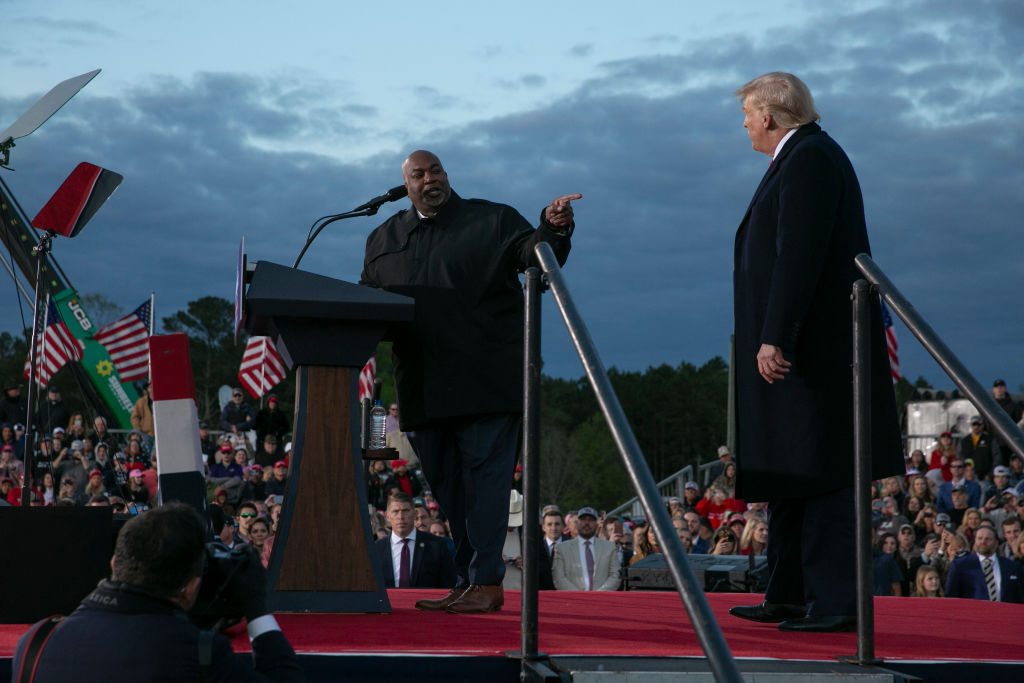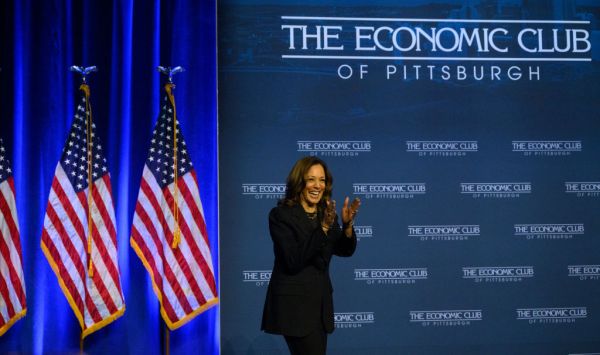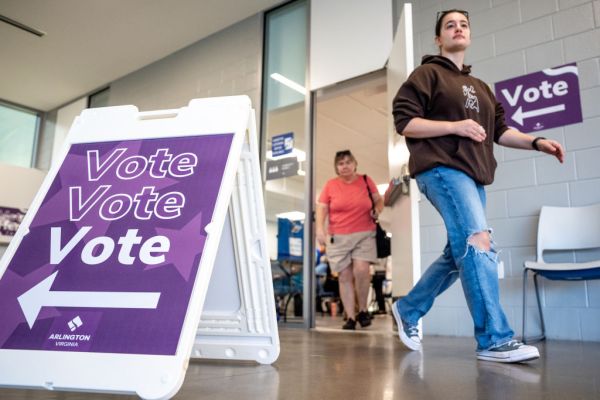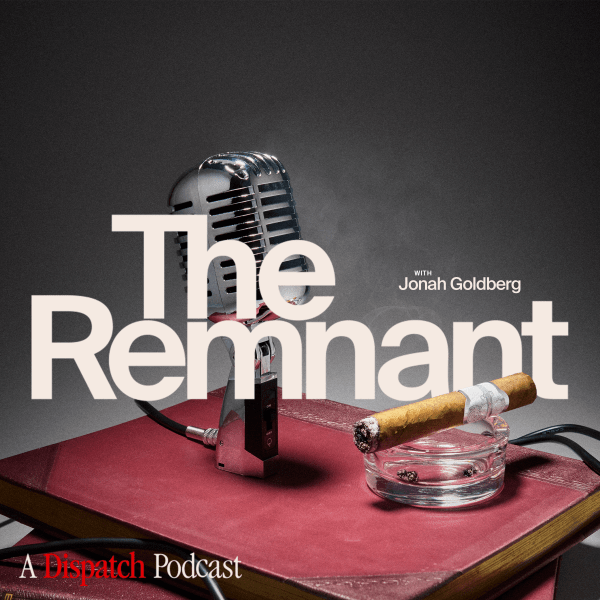
No one could listen earnestly to Vice President Kamala Harris or former President Donald Trump talk about their economic proposals without getting a toothache.
The economic illiteracy that the major party nominees for president evince when they discuss these matters is only surpassed by the shamelessness with which they pander.
Trump talks about tariffs with the kind of enthusiasm typically reserved for people selling ShamWows or miracle baldness cures. Harris weighs in on housing policy like she’s hawking swamp-adjacent timeshares. Both agree that nothing should be changed about our rapidly bankrupting entitlement programs and that millions of Americans should get huge tax breaks. Taxes down, spending up, huge duties on foreign goods: What could go wrong?
But I’ve got to tell you, I’m kind of here for it.
I have no doubt that the closing arguments from both campaigns will be like the ones we have seen since Barack Obama’s 2012 attack on Mitt Romney as unfit. That looks pretty tame compared to what we got in 2016 and 2020 when both parties argued not just that the other candidate was unfit, but that it would mean the end of America—and maybe the world—if the other side won.
But for now, we’re in the pandering phase. No taxes on tips or overtime, no changes to Social Security, millions of houses springing up like mushrooms after an autumn rain, the revival of the steel industry, free money for new parents, free money for new businesses—and on and on.
It’s unserious and unworthy of a nation as great as ours, to be sure. And it’s not like the campaigns have abandoned the apocalyptic talk, certainly not Trump. But while it may be a stupid version of the politics of attraction, pandering is still a version of positive persuasion.
Holy croakano! We welcome your feedback, so please email us with your tips, corrections, reactions, amplifications, etc. at STIREWALTISMS@THEDISPATCH.COM. If you’d like to be considered for publication, please include your real name and hometown. If you don’t want your comments to be made public, please specify.
STATSHOT
General Election
Kamala Harris: 48.2% (no change from last week)
Donald Trump: 46.8% (↑ 1.2)
[Average includes: CNN/SSRS: Trump 48% - Harris 47%; Quinnipiac: Trump 48% - Harris 48%; Ipsos/Reuters: Trump 44% - Harris 50%; Fox News: Trump 48% - Harris 50%; NYT/Siena: Trump 46% - Harris 46%]
Generic Ballot
Democrats: 48.0% (↑ 0.6 points from last week)
Republicans: 45.4% (↑ 0.4)
[Average includes: Echelon: 50% Democrats - 45% Republicans; NBC News: 48% Democrats - 46% Republicans; Monmouth: 48% Democrats - 47% Republicans; Marist/NPR/PBS: 46% Democrats - 45% Republicans; Emerson College: 48% Democrats - 44% Republicans]
TIME OUT: SOUTH SIDE SLIDE
Writer Sam Anderson spent weeks attending games of the Chicago White Sox, on track to set the Major League record for most losses in a single season. Here’s his dispatch for the New York Times: “I’d heard about Section 108. I’d been told that, even during this shambolic season … Beefloaf and his friends kept showing up, sitting in Section 108 to argue and cheer and complain. They represented a small, lonely remnant of a mysterious and dwindling species: the Chicago White Sox superfan. … They were like a big Greek chorus with a Chicago accent and a lifetime subscription to Baseball Prospectus. … ‘It’s a mental illness,’ Beefloaf said, succinctly. … In grisly forensic detail, the fans told me about organizational dysfunction: the bad trades and wasted draft picks and disastrous hirings. A season like this, they said, was overdue. … Right on cue, down on the field, the White Sox blew their 3-0 lead. … ‘This is actually the White Sox experience,’ Pete added.”
NEBRASKA GOP REBUFFS TRUMP, PRESERVING BLUE-WALL PATH
Cook Political Report: “On Tuesday, Nebraska Gov. Jim Pillen announced he wouldn’t call a special session of the state’s legislature, swiftly ending Republicans’ fierce eleventh-hour push to allocate Nebraska’s five electoral votes on a winner-take-all basis. Despite ferocious lobbying, the legislature’s swing vote – Democrat-turned-Republican state Sen. Mike McDonnell – wouldn’t budge from his opposition to the change. … Considering how red Nebraska is, it’s astonishing that the Democratic minority in Lincoln has been able to repeatedly stymie GOP efforts to guarantee Donald Trump an extra electoral vote. … If Harris were to lose all of the Sun Belt battlegrounds but hold onto the Great Lakes trio – plus the 2nd District – she would win exactly 270 electoral votes. And going purely by today’s polls, that’s one of the most plausible election outcomes out of the many possibilities.”
Race to define Harris ramps up in Midwest: NBC News: “More than half of every dollar spent on ads in the presidential race from Sept. 1 to 20 were spent in Pennsylvania, Michigan and Wisconsin — with Pennsylvania alone drawing 1 of every 4 dollars spent, according to AdImpact. Add Georgia, and it’s more than 60% of the total. … And what those ad dollars are actually buying tells a key story about the campaign. Harris’ campaign is running an equal mix of positive and negative ads on broadcast TV, according to the tracking firm AdImpact, while former President Donald Trump’s campaign is running almost exclusively negative and contrast ads — a demonstration of how focused voters and both campaigns are on defining Harris. … Trump has essentially stopped running any positive ads of his own on broadcast TV.”
Is the GOP Electoral College advantage shrinking?: New York Times: “The simplest way to measure the advantage in the Electoral College is to take the difference between the national popular vote and the vote in the ‘tipping-point’ state. … Right now, Vice President Harris leads the polling in the national vote by 2.6 percentage points, and leads Wisconsin — the current tipping-point state — by 1.8 points, which makes Mr. Trump’s advantage less than a point. By this measure, Mr. Trump’s advantage is only around one-fifth as large as it was four years ago, when President Biden fared 3.8 points better nationally than in Wisconsin (the tipping-point state in 2020). … On the one hand, Ms. Harris is holding her own in Michigan, Wisconsin and Pennsylvania. … The second half of the explanation, oddly, is that Mr. Trump is gaining in noncompetitive states like New York, improving his position in the national popular vote without helping him in the most important states.”
SENATE DEMS TRY TO MAKE GOP PLAY DEFENSE IN TEXAS, FLORIDA
The Hill: “The Democratic Senatorial Campaign Committee (DSCC) announced Thursday that it’s launching a ‘multimillion dollar’ television ad buy in Texas and Florida targeting vulnerable GOP Sens. Ted Cruz (Texas) and Rick Scott (Fla.). … The announcement comes as a surprise, as Democratic senators did not expect their campaign arm to sink resources into those two big and expensive media markets while they also are aiming to defend endangered Democratic incumbents in Montana, Ohio, Nevada, Pennsylvania and Wisconsin. … The DSCC’s announcement was greeted enthusiastically by Texas Rep. Colin Allred’s (D) campaign. … Cruz’s campaign expects Democrats to spend substantially more money in Texas than he will be able to raise to defend himself.”
Independent gains traction in ruby-red Nebraska: Cook Political Report: “The new poll … finds the race in another statistical tie, [independent union leader Dan Osborn] 45% - [GOP Sen. Deb Fischer] 44%. … It’s also notable that Osborn is attracting 18% of GOP voters and winning independents by a more than two-to-one margin (57%-24%). … efforts to boost an independent candidate in Utah in 2022, Alaska in 2020 and in Kansas in 2014 were unsuccessful, and the final result ended up being much wider than polling had indicated. … However, it does appear Osborn is a unique enough candidate that he is — for now — transcending party lines. … There is still a much more plausible path to Fischer growing her support in this race, and we remain very skeptical about Osborn’s path to 50%. … But the surge in GOP money in what should be a sleepy contest and the polling trend line, make it clear this is no longer a Solid race.”
Alsobrooks paints Hogan as GOP’s 51st vote: Wall Street Journal: “Larry Hogan’s run as a centrist Republican who regularly criticizes former President Donald Trump—even rejecting his endorsement—has made Maryland the nation’s most unusual Senate race, forcing many Democrats to make hard political calculations. … Democrats’ message boils down to reminding voters that Hogan is still a Republican—and that sending a Republican to Capitol Hill is different from electing one to run the state. … Hogan is getting deep-pocketed help: Maryland’s Future, an independent political-action committee … placed an $18.3 million ad buy on radio and television, starting this week. … Democrats’ TV ads cast him as a rubber stamp for party heavies such as Sens. Ted Cruz and Mitch McConnell in a prospective GOP majority. For many Democrats, abortion rights are the best example of the race’s stakes.”
BRIEFLY
Polls: Dems hold narrow leads in California battlegrounds—USC Today
The New York suburbs that will decide the House—New Yorker
New York City Mayor Eric Adams charged with bribery and fraud—New York Times
WITHIN EARSHOT: A BOY NAMED MIKE
“My staff ran a genealogy report. I’m the half fifth cousin four times removed of Johnny Cash.”—Speaker of the House Mike Johnson proudly claims a distant familial connection at a statue unveiling for the legendary American singer-songwriter.
MAILBAG
“Your article is mostly right on. I have one place you could be off, though. That is where many of us voted for Biden last time around because we could not stomach voting for Donald Trump but then found we had been hoodwinked. I have found a number of people are willing to go ahead and vote Republican this year despite Trump being at the top of the ticket just because they are not going to risk another four years of the Democrats at the helm of the executive branch. People have short memories of how corrosive Donald Trump was as president. They are not listening to his campaign rhetoric. They have accepted the criticism dismissing his abuse as ‘mean tweets.’ Fatigue has set in and so many Republicans are ready to just move on. If that means putting Donald Trump in office for another four years so be it.”—Mike Ritter, Fairfax, Virginia
Mr. Ritter,
I don’t disagree with your analysis, and I don’t think the piece does, either.
I’m arguing that part of the reason that Trump is polling better than he was at this point four and eight years ago is that Republicans are more united behind him. Trump is a known commodity, and the overwhelming majority in your party can live with the man for who he is rather than take a chance on another Democrat.
Similarly, the minority of Republicans who will never vote for Trump don’t have much trouble expressing themselves, either.
The kinds of voters you’re describing four years ago were perhaps unwilling to go all in on Trump as early as September, but now accept their fates in a way they couldn’t before. And remember that many of the people who thought as you did ended up not voting for Biden but holding their noses and voting for Trump anyway.
The question before us now is whether Trump is polling better or doing better than he was last time. If it’s the former it could be a combination of the voters like you and adjustments to polling methods by public opinion research professionals determined to not get it wrong a third time in a row.
If he’s actually doing better and will again see a bounce of almost 4 points from his final polling average to the national popular vote, he’s on his way to a popular majority and a smashing victory in the Electoral College—the best for a Republican since 1988.
I think that’s less likely, but certainly still possible. Which it is depends on the much more unknown quantity of Kamala Harris and her ability to persuade not those folks who have already made up their minds in favor of Trump but those who are still harboring doubts about him. If she can be seen as a fairly safe alternative to those voters, she’ll be the one doing the smashing.
All best,
c
“Given the sudden interest that the Republican Party is expressing in Nebraska’s system of distributing its electoral votes proportionally by congressional district instead of the winner-take-all method used by most states, would a proportional system used nationally would have any effect in reducing the partisan extremism you have discussed in so many columns? It does seem that a proportional system would force Democrats to campaign more widely than New England, New York, the Upper Midwest, and the West Coast. Likewise, the Republicans could no longer count on the South and Mid-Continent. Your thoughts please.”—Blair Gardner, Valparaiso, Indiana
Mr. Gardner,
It is good to hear from you again! But I’m afraid I have to burst your bubble a bit on the idea of a proportional Electoral College.
If we applied that idea to your home state’s 11 electoral votes in 2020, Donald Trump would have won 6.26 electoral votes, Joe Biden would have won 4.5 and Libertarian Jo Jorgenson would have won .21 percent of an electoral vote. I think you know where this is headed, but imagine doing that in all the states. I’m not going to do the math, but I’m very sure that the business of getting to 270 electoral votes would be difficult in such a system.
Now, we could amend the Constitution to change the rules of the Electoral College and make it a first-past-the-post system, but I think the likelihood of confusion and plurality victories would be high.
Fortunately, Nebraska and Maine point us toward a much more elegant solution: the James Madison plan in which we decide electoral votes on the House district level with a two-vote bonus for winning the state as a whole. Instead of 51 contests, you’d have 487 separate winner-take-all contests (each House district, every state, and the District of Columbia) to get to the total of 538 electoral votes, keeping the simple majority at 270.
I think that would deliver the same benefits you seek without the dangers of fuzzy math and the hassle of amending the Constitution. I hope other states will follow the path laid out in Nebraska and Maine.
All best,
c
“Recently on an episode on the soon to be world-famous podcast Ink Stained Wretches you had a brief discussion about the difficulty that the U.S. has in talking about class and (I think) race. I was hoping to reference that to a friend but couldn’t find it in your writing and was hoping you might describe the position once more. In my view, this would make an exceptional column, but I will settle for a mailbag answer.”—Rehm Maham, Austin, Texas
Mr. Maham,
Americans pride themselves on having a classless society, but that’s not true. This is partly because the members of the upper classes do not like to think of themselves that way at all. Indeed, the trend has been for people to minimize their own status.
Who would happily declare themselves to be “upper class” in today’s populist America? Of course, anyone could be middle class, provided the middle is defined widely enough. If, as the Gallup poll linked above indicates, 54 percent of Americans consider themselves middle class, that’s a pretty meaningless distinction.
But, sadly, Americans have little trouble talking about race. It has, understandably, been the most contentious part of our politics. From the Constitutional Convention to the Civil War to Jim Crow to Civil Rights to busing to police brutality, the shadow of slavery has hung over American politics.
Racists, both malicious and paternalistic, developed and still maintain a whole way of seeing the world through the lens of disparities between black and white Americans. This way of thinking has been applied to Hispanic Americans and immigrants from Africa and Asia and their descendants.
Focusing on race makes white people feel superior, either in the wicked eugenic sense or in the concept of “privilege,” in which a superior and advantaged race distinguishes itself as an “ally” to the oppressed. Just try getting a white person to admit their privilege because of a high income. But ask them to admit “white privilege,” and many will oblige.
This racial obsession means that when we talk about demography for purposes of policy and politics, we are very prone to focus on race when we are really seeing class at work.
Clay County, West Virginia, has a per capita income of $16,827 and an employment rate of 39.6 percent. It has 7,671 white residents with the largest non-white subgroup being Hispanic or Latino, with 52 individuals in the 2020 Census.
Kemper County, Mississippi, has an almost identical size in population, but is majority black—61 percent in the 2020 Census. It has a per capita income of $12,903 and an employment rate of 43.6 percent.
These are some achingly poor places with lots of similarly sad stories to tell about life expectancy, educational attainment, and child poverty. But maybe the difference between those per capita incomes—almost $4,000 a year—is because of race.
However, if we look at someplace like Charles County, Maryland, which is about 50 percent black and only about a third white, we find a per capita income of $62,942.
Granted, a dollar goes a lot farther in Wallback, West Virginia, or Sucarnoochee, Mississippi, than it does in the suburbs of Washington, D.C., but not $50,000 worth. How do we account for the dramatic differences between the people in the places?
I’m not saying that race isn’t a factor at all, but I am saying that life and attitudes in Kemper County are probably more like those in Clay County than they are to those in Charles County, regardless of the ancestry and ethnicity of the residents.
When we talk about how issues affect different groups of Americans, we are prone to focus on race because of the raw place it occupies in our collective consciousness and are unlikely to talk about class in a country where people tend to lack self-reference about their own stations in life.
But often what we are talking about when we discuss disparate impacts of trends and policies on questions of race are really about income and status. Black Americans are, sadly, overrepresented among the ranks of the poorest Americans but poor black people are not that different from poor white people, poor Hispanic people, etc.
When you see a statistic that points to disparate racial outcomes on questions about quality of life, think about Clay County, West Virginia, and ask yourself whether what is being said about race is really about wealth. It won’t always apply, but in many cases you will find that perceptions change.
All best,
c
You should email us! Write to STIREWALTISMS@THEDISPATCH.COM with your tips, kudos, criticisms, insights, rediscovered words, wonderful names, recipes, and, always, good jokes. Please include your real name—at least first and last—and hometown. Make sure to let us know in the email if you want to keep your submission private. My colleague, the hardy Nate Moore, and I will look for your emails and then share the most interesting ones and my responses here. Clickety clack!
CUTLINE CONTEST: STAND BY FOR NEWS

Our final week of the September Cutline Contest presents a familiar dilemma to contestants: Too much. A wild-looking photo pegged to the even wilder story of North Carolina Lt. Gov. Mark Robinson’s scandal-soaked gubernatorial campaign is funny on its own, so what’s a wag to do? The answer this week for an entry into the monthly contest and a shot at the annual ham prize is to go straight at the target:
“Following Donald Trump’s assertion that the craziest news story of the week is immigrant dietary oddities, North Carolina Lt. Gov. Mark Robinson invites him to ‘hold my beer.’”—Cannon Alsobrook, Smyrna, Georgia
Winner, Peppy Pepperoni Division:
“No, Donald, I swear, I didn’t take the last slice of the pizza. I have no idea what happened to it, but it wasn’t me.”—Akino Yamashita, Tarrytown, New York
Winner, Truth Your Truth Division:
“North Carolina Lt. Gov. Mark Robinson acknowledges inspiration for his development of new social media website.”—Linda McKee, DuBois, Pennsylvania
Winner, The Ties That Bind Division:
“Hey, don’t I know you from the Long Tie Lovers Forum? ‘BigHands45,’ right?”—Tripp Whitbeck, Arlington, Virginia
Winner, Tipper Gore Division:
“We’re sorry, but the contents of this conversation have been edited due to their graphic nature.”—Jeff Tatusko, Plum, Pennsylvania
Winner, Some of His Best Friends Division:
“Wait … you mean you’re not Tim Scott!?”—John Rawls, Castle Pines, Colorado
Winner, Pageant of the Masters Division:
“Mark Robinson attempts to reenact Michelangelo’s The Creation of Adam with an uncooperative Donald Trump.”—Rick Whaley, Portage, Michigan
September Winner
While Mr. Alsobrook’s direct approach was good enough for the weekly laurels, no one was likely to get past one of the shortest, sweetest entrants ever to grace the Cutline Contest. September’s winner is reader Dave Carter of Palmer, Alaska, who scored big with “5 yards, encroachment” on this photo of Gwen Walz with her husband, Minnesota Gov. Tim Walz, and Vice President Kamala Harris at the Democratic National Convention.
Please provide us your mailing address, Mr. Carter, so we can send along your prize, a Jack Kemp rookie card from the 1996 Republican vice presidential nominee’s debut with the American Football League's 1960 Los Angeles Chargers.
HATCHING A PLAN
SF Gate: “Why did the chicken cross the road? In San Francisco, it’s to catch motorists breaking the law. … On Monday morning, San Francisco police Lt. Jonathan Ozol wore a flamboyant, inflatable chicken costume as he attempted to navigate a crosswalk. … The purpose of the exercise was to issue tickets to drivers who flouted state law by not yielding to a pedestrian like Ozol as he attempted to cross. … The intersections and costumes often change, but the mission is the same: To ensure drivers are paying extra attention as they approach a crosswalk. … ‘If you don’t see someone in a giant chicken costume, then we really have a problem,’ he said. … Over the next hour, police pulled over so many drivers that I eventually lost count. Hurwitz guessed that the previous five exercises — other costumes include a unicorn and ‘Sesame Street’s’ Big Bird — resulted in 30 to 40 citations each.”
Nate Moore contributed to this report.






Please note that we at The Dispatch hold ourselves, our work, and our commenters to a higher standard than other places on the internet. We welcome comments that foster genuine debate or discussion—including comments critical of us or our work—but responses that include ad hominem attacks on fellow Dispatch members or are intended to stoke fear and anger may be moderated.
With your membership, you only have the ability to comment on The Morning Dispatch articles. Consider upgrading to join the conversation everywhere.